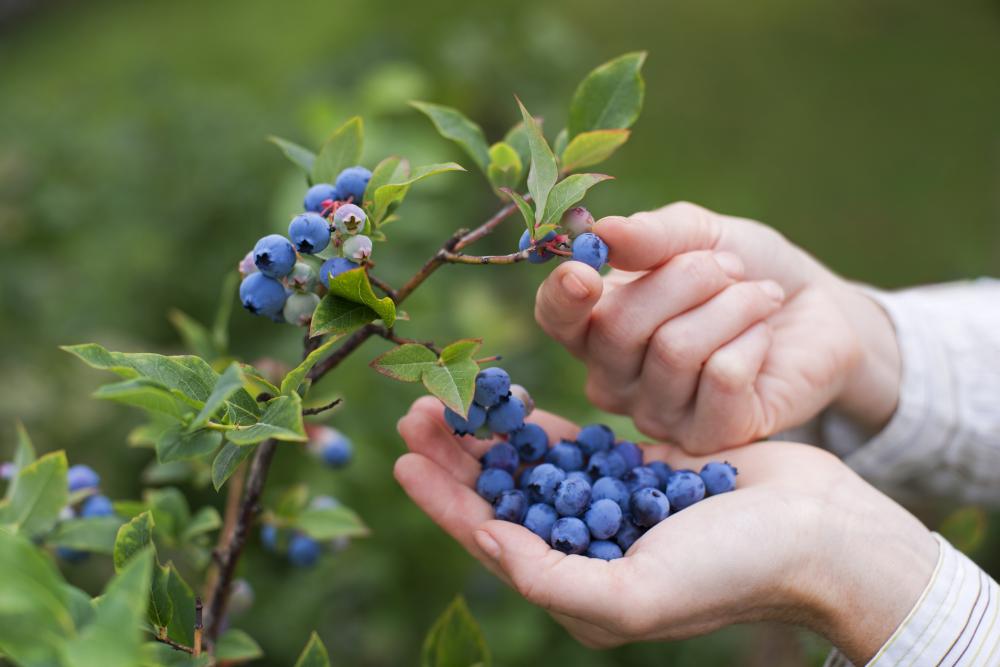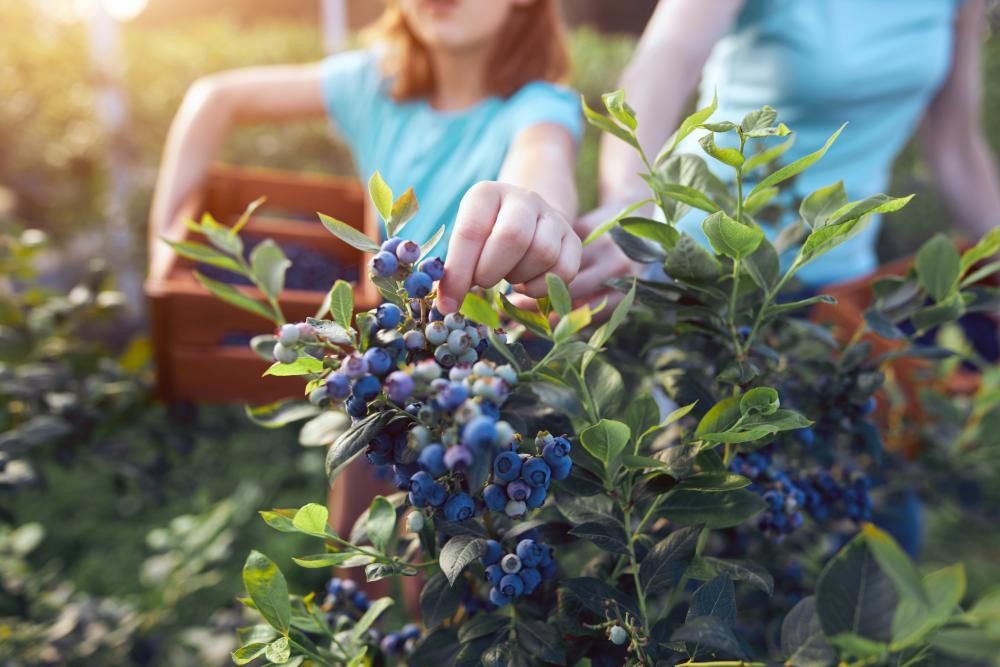Blueberry Disease Control – How To Keep Blueberries Growing Healthy
Although considered a relatively easy plant to grow, blueberry growers can face many problems before they can harvest the delicious berries. Most of these growing problems have to do with the conditions around the plant and the amount of care they receive.
But sometimes those problems can be beyond your control. Blueberry disease control is an integral part of caring for the fussy berries. For the most part, you’ll be fighting off mummy berry disease, fending off chlorosis, trying to prevent the spread of stem canker, and looking for ways to keep stem blight at bay. Nobody said that caring for blueberries was easy.
But before you throw in the towel and swear off blueberry growing altogether, read this article to find out how to deal with the different blueberry diseases and save your crop every year.
Blueberry Mummy Berry Disease
It first appears as brown discoloration of the main vein of the leaves of the blueberry shrub. It might just be one or a handful of leaves. But it’s not such a serious symptom that you might easily ignore it. The next time you look, the brown color has covered the rest of the leaf and moved to the new shoots and stems.
When it finally reaches the blossoms and buds, they will wilt and drop, followed by the new shoots and the leaves. In short order, you can easily lose your crop while the shrub itself hangs in the balance and is one step from toppling over.
The culprit behind the blueberry mummy berry disease is Monilinia vaccinii corymbosi, a fungus that causes new shoots to curve like hooks. Since this is the same symptom as frost damage, you might overlook the disease and hope the shrub will get better as the weather warms up.
But of course it doesn’t get better. And the berries will not ripen on the shrub. They’re already infected with the spores of the fungus.
How to Fix It
Proper care is important for the success of the blueberry bush. Even when nothing seems to be wrong with the plant, you need to do your regular checking to detect any signs of the disease early on and take action. The blueberry mummy berry disease takes hold of the developing berries, eats out the core of the berry, and fills it up with fungal spores. To prevent this disaster from taking over the whole shrub and any neighboring plants you need to do the following.
- Check for the early signs of the disease on the deep veins of the leaves. If you notice the brown color taking over, remove the infected leaves and branches. Dispose of them in the fire.
- Clean under the shrub and remove any debris. Burn the fallen leaves especially if they’re infected.
- Pick an unripe berry at random and split it open. If you find the core replaced with white fungal flesh, cut off the whole branch and burn it.
- Sanitize your gardening tools before and after you use them on the blueberry shrub.
- Check the berries on the shrub and look for mummified ones. They’re usually black and smaller than healthy ones.
- After harvesting, cut back the shrub by one-third and keep looking for signs of the disease. The fungus overwinters on the shrub and comes back to life in the spring.
Blueberry Chlorosis
Balanced fertilizers and plant food supplements are crucial for the success of the blueberry shrub. Sometimes lack of essential nutrients such as iron can leave the plant open for serious and even lethal diseases. Iron deficiency is known to make the shrub weak and that’s when chlorosis develops.
The symptoms start innocent enough. The leaves turn yellow even in the middle of the growing season. Again you might chalk it up to weather conditions or dry soil. But then the branches wilt and the shrub seems like it has stopped growing altogether. Of course, fewer blooms develop and the crop can be meager at best. Eventually, the shrub dies.
Besides iron deficiency, another factor that causes this disease is the alkaline soil. High soil pH makes the shrub too weak to resist diseases.
How to Fix It
Proper feeding and regular checking of the soil are two keys to a healthy blueberry shrub. Since there’s no way for you to stop pathogens from attacking the plant, the only way is to shore up the defenses of the blueberry so that it won’t become easy prey to the blueberry chlorosis. Here are a few steps you can take.
- Test the soil regularly to make sure the pH levels are low. Amend the soil with lime to bring those levels down to neutral or slightly acidic. Keep in mind that you’ll need to add one inch of lime for every square foot to reduce the pH by a half-point.
- Send a sample of the soil to the local agricultural department to check for iron deficiency.
- Use a foliar iron spray as a food supplement if you notice signs of stunted growth or leaves looking smaller than usual.
- You can use sulfur to reduce the soil pH instead of lime but sulfur applications can be complicated.
- Don’t allow the soil to dry out completely since that increases the alkalinity of the soil and opens the door for blueberry chlorosis.
- Cover the ground under the shrub with a thick layer of mulch. It helps with water retention and when the organic materials break down, they increase the acidity of the soil.
Stem Canker On Blueberry
The mere mention of the word “canker” sends shudders down the spine of the blueberry grower. It usually implies some pathogen growing and festering under the surface of the branches and threatening to bring the whole bush down.
Botryosphaeria stem canker is one of those fungal infections that are not easy to deal with. For one thing, there’s no cure for the disease. So it’s better to detect the early signs of the infection and try to prevent its spread as much as you can. So what are these symptoms?
The first signs appear in the early spring. Small lesions appear on the stems. At first, they’re red. Then they darken and spread across the diameter of the branch. Girdling is the next development and once that happens, the branch is as good as gone.
The spores of the fungus overwinter in the infected stems and spread to new shoots in the next spring. So how do you deal with an infection like that?
How to Fix It
When it comes to stem canker and blueberries, the word that comes to mind is prevention. It’s a lot easier to protect the bushes from the infection than to try to treat it once it takes hold under the surface. And with no fungicide to treat it, the only way to deal with it is to prevent its spread.
- When you notice the first stem cankers on a branch, cut the branch 8 inches below the first canker.
- Use sterilized tools to prune, cut, and remove infected stems.
- Don’t buy shrubs from unreliable sources.
- Always check the young shrubs for signs of the disease before buying them.
- Don’t plant blueberry shrubs in an area of the garden that was infected by the fungal pathogen.
- Burn infected stems as the safest way to get rid of the pathogen and stop its spread.
- If you live in the southern parts of the US where the stem canker is prevalent, choose disease-resistant blueberry varieties.
Blueberry Botrytis Blight
Although botrytis blight is a serious disease that’s common among blueberry bushes of different varieties, it also infects other plants in the garden. So the danger is double-fold here as not only do you risk your blueberry crop but also the rest of the plants growing in the vicinity of the bush.
Botrytis cinerea is the fungus that causes this disease. It becomes active in high levels of humidity. And like other fungal infections on this list, there’s no treatment for blueberry botrytis blight. Still, it’s not all doom and gloom in this story. You can still save your blueberry crop and the bush itself even when the fungus hits. You just need to recognize the symptoms of the disease early on and act accordingly.
The symptoms of blueberry botrytis are always the same. The fungus covers all parts of the bush with gray hairy growth. The leaves, stems, blossoms, and even berries become enveloped in the gray web-like a mummy. New shoots that haven’t been covered yet will have dark tips. And the flowers will look unhealthy with a watery appearance. All in all, it’s not a good sight and you can’t help but feel sorry for the shrub.
How to Fix It
The fungicides in the market are practically helpless when it comes to blueberry botrytis. Moreover, the fungus quickly develops resistance to the fungicides so repeated spraying will not stop the spread of the gray hairy growths. Your best course of action is to prevent the fungus from infecting the shrub in the first place.
- Air circulation is the first weapon you can use against fungal spores of all types. Stagnant air and lack of ventilation, when combined with high humidity, can turn the bush into a breeding ground for the spore.
- Space the shrubs and take down any structures that cast a shadow on the shrub or keep the wind from infiltrating the inner stems.
- The soil should be loamy or sandy to drain the water fast and prevent humidity buildup.
- The blueberry bush should get at least 8 hours of sun during the spring and summer.
- Don’t sprinkle water on the foliage and water the shrub in the early morning to give the sun ample time to dry out any excess water on the stems or leaves.
Spots On Blueberry Leaves
Spots on blueberry leaves are a sign that your shrub has one of many diseases. The two most common ones are anthracnose and septoria. Sometimes, it’s more than one disease especially if the bush is infected with Alternaria leaf spot fungus. All of this makes your job of saving the shrub a lot harder. The signs are usually red spots on the leaves. And instead of the lush green color, the leaves turn yellow.
As with most fungi, the main factor that facilitates the spread and activation of any of these diseases is high humidity. If your spring is marked with heavy rain, you need to watch out for fungal infections.
How to Fix It
You can save yourself and your blueberry shrubs a lot of trouble if you choose disease-resistant varieties. You should also keep the garden clean from debris and fallen leaves. Dispose of all debris safely by burning it. And if you discover the disease in the shrubs, remove the infected stems quickly and burn them. With the right precautions and taking action quickly, you can save your blueberries and stop the fungal spores in their tracks.


